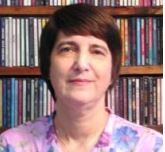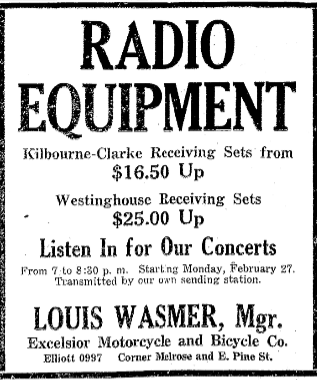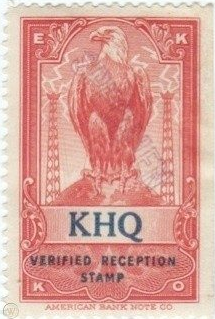KQNT (KHQ) – 100 Years and 300 Miles

In 1920, commercial radio was making its debut in cities like Detroit, greater Boston, and Pittsburgh. Quickly came the start of the so-called “radio craze,” when radio went from being a fad to becoming a national obsession.
The Department of Commerce (DOC) recognized this and in January 1922, decided to ban radio amateurs, who were also sending out voice and music to entertain their friends, from the commercial frequency.
LOUIS WASMER
In Seattle, Washington, a fast-growing city in the Pacific Northwest, one of the fans of amateur radio was Louis Wasmer.
Born Louis August Von Wasmer in 1892 at Grand Island, Nebraska, his family moved to Seattle when he was about eight years old. He became fascinated by wireless telegraphy when he was a young teen – by 1907, he was hired by the United Wireless Company as an operator, a job he held for three years.
In addition to the wireless, Wasmer’s other love was motorcycles. As early as 1913, he was judging motorcycle races in various cities, and working in sales at a Seattle motorcycle shop. By 1917, he had become the proprietor of his own shop: the Excelsior Motorcycle and Bicycle Company on Pine Street. By 1919 he gradually began dropping the “Von” from his last name; contemporary newspapers often referred to him as just “Louis Wasmer.”
BUILDING HIS OWN STATION
Much of Wasmer’s early career is difficult to verify, but Wasmer certainly kept up with the state of the art in broadcasting, and he seems to have had a reputation throughout the Pacific Northwest for knowing about the latest equipment.
For example, when a newspaper in Victoria, British Columbia, wanted to install a radio station in early 1922, the management called upon him to set it up. The editors praised his engineering skill, saying he was “recognized in the United States as one of the foremost experts in the radiophone business.”
Seeing the growing interest in commercial broadcasting, he decided to get involved personally.
 Wasmer applied for a broadcasting license and began selling radio equipment in his motorcycle shop, so that his loyal patrons would have the right equipment to listen to his new station when it went on the air.
Wasmer applied for a broadcasting license and began selling radio equipment in his motorcycle shop, so that his loyal patrons would have the right equipment to listen to his new station when it went on the air.
The DOC assigned his new station the call letters KHQ, but at first, his newspaper advertisements, like this one from the Seattle Daily Times, February 26, 1922, p. 8 identified the station by the name of Wasmer’s company, rather than by the call letters. He soon changed his motorcycle shop’s name to reflect that he now also owned a radio station – the “Excelsior Motorcycle and Radio Company.”
Wasmer’s new commercial station, the third on the air in Seattle, made its debut on Monday, February 27, 1922, from studios and a 10-Watt transmitter on the roof at the Wasmer home, 13th Avenue North and East Republican Street.
The station broadcast three nights a week, for one hour on Tuesday, Thursday and Saturday evenings (in those days, it was rare for any station to broadcast all evening, since there was only one approved frequency (360 meters, or 833 kilocycles) and all the stations in that city were expected to share).
EARLY PROGRAMMING
As usual in those early days, programming varied.
Sometimes, stations broadcast concerts featuring phonograph records; sometimes there was a live performance from a local entertainer; or perhaps you would hear an informational talk – on several occasions, to nobody’s surprise, KHQ featured talks about motorcycles.
Because ratings had not yet been invented, we have no way to know how popular KHQ or any of its competitors might have been, but we do the sale of radio sets increased throughout the year, and more stations went on the air: by November, Seattle had six stations, including KHQ, broadcasting regularly.
A SHORT MOVE
Sometime in mid-1922, KHQ moved its studios out of the Wasmer home (which his wife was probably happy to see) and relocated to 301 East Pine Street, to his motorcycle shop.
But Wasmer was doing more than running his motorcycle shop and his new radio station. In May, he helped to build and install another Seattle station, KDZE, owned by the Rhodes Department Store. Perhaps this engineering work for KDZE and several other local stations impacted the amount of time he could focus on KHQ. Throughout 1923 and 1924, KHQ generally continued to broadcast an hour-long program three nights a week. About all we know about KHQ at point is that most of the time, the station relied on concerts of phonograph records. However, newspapers reported the station was off the air for several months over the summer, and that he installed a higher-powered transmitter at new studios prior to returning to the air in November.
For various reasons including the interrupted operation, KHQ essentially received very little publicity. Nor apparently did Wasmer seek it out from the many radio magazines now being published.
MORE VARIETY
In mid-January 1925, Wasmer finally found a solution to KHQ’s over-reliance on phonograph records.
He entered into an agreement with the Bush & Lane Piano Company, which began providing live music from local entertainers, directed by Frank A. Buhlert. Buhlert had been working in the advertising business, and now he was arranging that store’s new venture into broadcasting – they installed a new studio in the company’s store on Third Avenue in Seattle.
By late January, KHQ was sending out concerts from popular local orchestras, programs from opera singers and classical violinists, plays that had been adapted for radio, an evening of folk music, and much more. Sometimes, KHQ was even on the air for a live afternoon music concert. Listeners were undoubtedly pleased to hear so much more variety.
At that time, KHQ was using 100 Watts, but the management of Bush & Lane hoped to eventually boost the station’s power. But then, in mid-May, there was an announcement in the newspapers that KHQ would be temporarily shutting down, ostensibly to “make extensive alterations in the radio studio.”
And so it was that KHQ left the air, but as it turned out, the shutdown was not temporary. In fact, KHQ never returned – at least not in Seattle.
MOVING A LOT FARTHER
Most listeners were probably unaware that Louis Wasmer was in negotiations to relocate KHQ to the city of Spokane, about 300 miles away, in the eastern part of the state.
The news began to appear in Seattle’s (and Spokane’s) newspapers in early August 1925. In fact, it made the front page in the Spokane Daily Chronicle, where a huge headline on August 4th announced: “Install Radio Station in Spokane. High Power Equipment Valued at $30,000 Will Be Built During Next Month – Will Do Commercial Work.”
Subsequent articles said that Frank A. Buhlert, who had arranged the programs for the Bush & Lane broadcasts, would come to Spokane to help run the new KHQ, and his wife Constance would be the station’s studio hostess (what we today would call the receptionist).
A BOOST IN PUBLICITY
Of course, KHQ was not Spokane’s first station.
There were a few small stations that came and went there in broadcasting’s first several years, including the Chronicle’s own 10-Watt radio station, KOE, which broadcast sporadically for about five months in 1922.
When KHQ was preparing to arrive in Spokane as a 500 Watt station, with an application pending to boost its power to 1000 Watts, there was already a radio station operating in Spokane and doing quite well: KFPY, owned by the Symons Investment Company.
KFPY had been on the air since May 10, 1924, using state-of-the-art equipment and a 100-Watt transmitter. Needless to say, station owner Tom Symons was not amused to hear that Louis Wasmer was about to come in with 500 Watts, let alone 1000. And making matters worse, even the local newspapers seemed to take KHQ’s side: the Chronicle editorialized that “Installation of station KFPY… gave Spokane a small place on the radio map, but because of its limited broadcasting radius, it has not given Spokane equal representation with other cities…” It then added that radio fans would eagerly welcome the new “1000 Watt broadcasting station that will rank with the best in use in the country…”
In other words, KFPY would soon have competition, and it looked like Wasmer’s station had an advantage even before it went on the air for the first time.
MOVING ALL THE WAY TO SPOKANE
According to legend, when Wasmer left Seattle, he packed up his station and put it in the sidecar of his motorcycle.
But this is unlikely, given all the pieces of equipment he already owned, the new equipment he had begun to purchase, and the long journey between Seattle and Spokane. More likely, he put a few items in his car (in addition to loving motorcycles, he was an automobile enthusiast), and when he arrived in Spokane, he and Frank Buhlert got to work deciding what they could use from Seattle and which new materials they needed to purchase. (For example, according to the Spokane newspapers, KHQ was going to install a 70-foot aerial, and “two specially selected wooden poles” were being erected on the roof of the station’s new building; “guy wires totaling more than a half a mile will” were to be used for supporting the poles.)
But whichever way KHQ got there, the station’s arrival in Spokane had a major impact on broadcasting in that city.
WELCOME TO TOWN!
In October 1925, Spokane radio fans were eagerly awaiting KHQ’s debut – among them was U.S. Senator Clarence C. Dill, who would soon play a key role in creating the Radio Act of 1927 and the Federal Radio Commission.

c. 1925
The all-new KHQ went on the air on Friday October 30, 1925, at 8 P.M., operating at 273 meters (1100 kilocycles). Among the many voices the listeners heard sending greetings and congratulations that night were political leaders (including Washington State’s lieutenant governor), several university presidents, the head of Spokane’s ministerial association, and the head of the Spokane’s Chamber of Commerce.
Then, the musical part of the program commenced, featuring popular local bandleader Leonardo Brill and his orchestra, as well as numerous other local entertainers – pianists, vocal ensembles, an expert on tourism (who extolled the region and invited listeners from distant locations to visit), and many others. Reception was good too: the station received more than 300 telegrams, most from various cities in the Pacific Northwest, but a few from as far away as St. Paul, Minnesota. It was a four hour extravaganza, “one of the most elaborate programs of its kind ever offered.”
DOC, THEN FRC ISSUES
Completing the move from Seattle to Spokane had been costly.
Wasmer planned to install a new 1,000 Watt transmitter. Doing that, plus completing the transition into new studios, would be at least a $30,000 investment (the equivalent of $400,000 today). Actually, to that point, he had only been granted permission to use 500 Watts (although occasionally experimenting with the full 1,000). To get the license for 1000 Watts, KHQ would have to demonstrate that it was not interfering with any other stations,
Wasmer was confident that would not be a problem, certain the DOC would soon grant the approval for 1,000 Watts.
But while the listeners undoubtedly were glad to have a new and powerful station in town, even at 500 Watts, KHQ had far more power than the other stations in the market. Tom Symons, who owned KFPY, the chief competitor to KHQ, was concerned. Louis Wasmer claimed his 1,000 Watt transmitter would not cause problems, but Symons and his station manager Ed B. Craney were convinced that it already did.
At first, KHQ was operating with 500 Watts (There would be no official okay from the Department of Commerce to use 1,000 Watts all the time until the spring of 1926.) However,. Symons and Craney were certain the new station was causing interference, and there were Spokane radio listeners who agreed with that assessment.

TRYING TO MOVE AWAY FROM TROUBLE
In mid-November 1925, KHQ was assigned a new frequency: 394.5 meters, or 760 kilocycles.
Still, some listeners believed that KHQ was overpowering other stations in the market. Wasmer insisted his station was not to blame – he attributed the problem to listeners with older radio sets, saying the newer sets were better able to tune into the specific station a listener wanted. But radio fans, determined to find better answers than getting a new radio, formed the Spokane Radio Listeners organization, with the goal of finding ways to eliminate interference and improve reception.
At their first meeting on November 19, 1925, about 200 people attended; also at the meeting were Senator Dill, and representatives from all the Spokane stations, including KHQ and KFPY. Everyone joined in a conversation about how to solve the interference problems many listeners were experiencing. (In truth, the meeting was about more than just KHQ; the listeners had complaints about other stations too.)
Everyone decided to meet again in December to keep the conversation going.
MORE TROUBLE
Meanwhile, the rivalry between KFPY and KHQ intensified. Each station tried to one-up the other by getting new and better performers, or broadcasting interesting special events. But KFPY’s management kept encountering examples of what seemed like KHQ taking unfair advantage.
For example, in 1925, stations were still sharing a limited number of frequencies. One station might get an hour on the air on Monday at 7 P.M., then another was supposed to get an hour at 8 P.M., etc. But increasingly, stations were not giving up the frequency as agreed so that another station in the market might have its turn. In late December, KFPY’s station manager Ed B. Craney accused KHQ of “hogging the air on KFPY’s time,” causing KFPY to cancel a scheduled program.
Craney said it had happened before, and that KHQ seemed to believe that because it was a bigger station, it could ignore its agreement to give KFPY its turn. Craney was sufficiently outraged to complain to the Radio Inspector, Otto Redfern, who supervised all the stations in the 9th Radio District (which included Washington).
Was KHQ to be slapped down by the Radio Inspector and lose its license? Well, of course you do know from the title of this article that KHQ survived. How it happened, and the rest of the station’s history is in Part 2.
She is the author of six books and many articles about the history of broadcasting. Contact her at: dlh@donnahalper.com
Return to The BDR Menu
